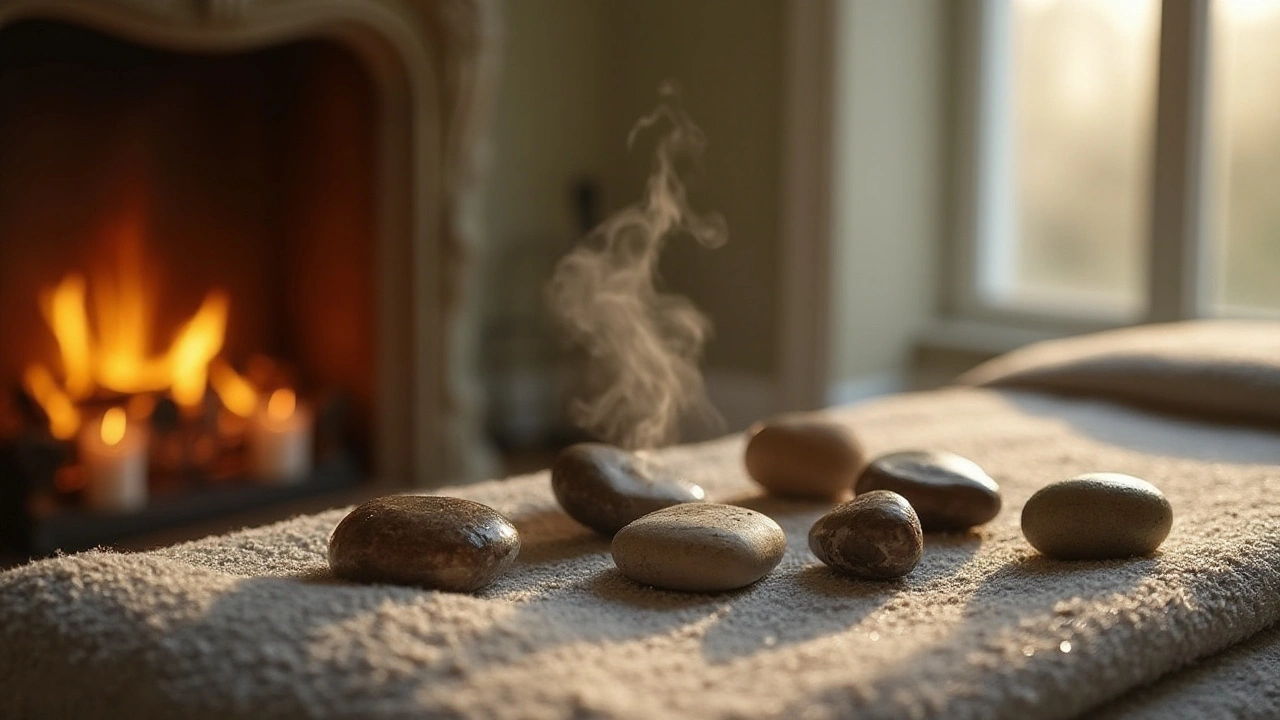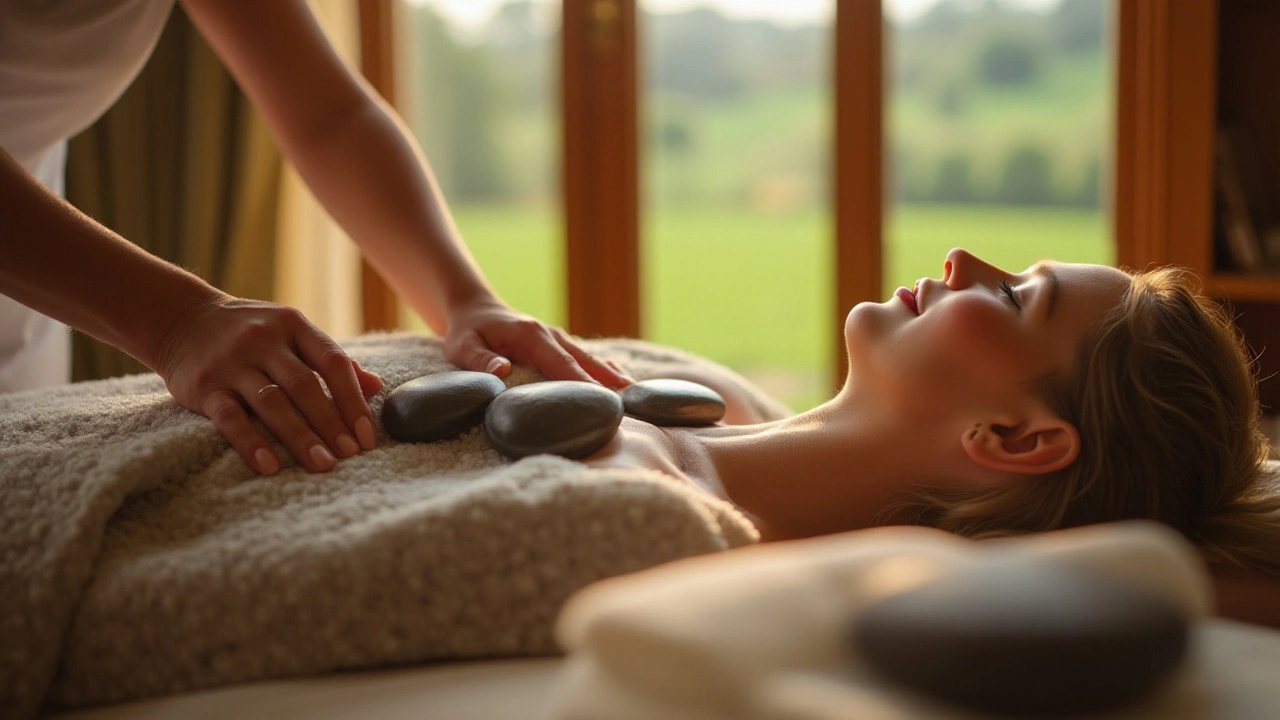In the bustling age of modern life, finding new and natural ways to boost our well-being is more essential than ever. Enter stone therapy, a time-honored practice that beautifully blends the earth's raw elements with therapeutic techniques aimed at nurturing both body and mind.
This soothing method roots itself in various ancient traditions, where warmed and cooled stones are intuitively placed or massaged along key points of the body, guiding us towards a state of harmony and peace. Whether you've heard tales of its restorative powers or are curious to try something new, stone therapy may just be the missing piece on your journey to wellness.
- The Origins of Stone Therapy
- How Stone Therapy Works
- Benefits for Physical Health
- Emotional and Mental Wellness
- Choosing the Right Stones
- Incorporating Stone Therapy into Daily Life
The Origins of Stone Therapy
When you think about ancient healing practices, considering the use of stones might not be the first thing that comes to mind. Yet, stone therapy is deeply rooted in the annals of human history, with echoes found in several ancient cultures across the globe. The use of stones for healing dates back thousands of years, with significant practices observed in cultures spanning from Asia to the Americas. One of the earliest recorded uses comes from China, where records suggest that heated stones were employed over 2,000 years ago to aid the body in reducing muscle aches and improving overall vigor.
Interestingly, the Indigenous peoples of North America were also well-versed in similar practices, using stones in their spiritual healing rituals. These communities recognized the earth's natural gifts, understanding the impacts of temperature and mineral properties on the human body and spirit. Stones, often sourced naturally from rivers or volcanic landscapes, were considered not just physical aids but were imbued with spiritual essence, offering nourishment to the body and the soul. As far-reaching as these practices are, stone therapy today continues to draw inspiration from these ancient traditions, evolving into both an art and science of healing.
In the Indian subcontinent, stone therapy finds its roots intertwined with Ayurveda—the ancient system of medicine. According to Ayurvedic principles, body's energy points, or chakras, could be balanced using natural elements including different types of stones, each selected for its unique properties. This traditional knowledge is paired with a belief in holistic well-being, aligning the physical, emotional, and spiritual facets of an individual for comprehensive healing. A fascinating fact is that the Romans, known for their vast advancements, also adopted the use of heated stones in their famous public baths, aiding relaxation and encouraging the detoxification process through sweating.
Stone therapy has transformed over the centuries, yet the charm of these practices lies in their authenticity and connection to ancient wisdom. Even today, many therapists worldwide embrace these age-old techniques, harnessing the power of stones to bring about a sense of equilibrium and peace. As more people seek natural and non-invasive methods of healing, the legacy of stone therapy remains strong, promising a tradition that honors both history and health. It was the well-known historian Lindsey Stone who wrote, "By embracing the gifts of the earth, we empower roots deeply planted in our biological heritage to blossom once more." Her words resonate with those seeking connection through the elements, capturing the essence of how our ancestors viewed nature's power.
How Stone Therapy Works
Stone therapy, often synonymous with the stone therapy massage, is as much an art as it is a science. The technique primarily utilizes smooth, flat, heated stones strategically placed along the body's key points, which are often referred to as the energy centers or chakras. These stones, usually crafted from basalt due to their high heat retention properties, are warmed to a precise temperature that facilitates profound muscle relaxation without causing discomfort. As heat penetrates deep into the muscle layer, it encourages expanded blood vessels, boosting circulation and delivering essential nutrients to strained tissues. This heat also promotes better oxygen flow throughout the body, which can accelerate healing processes and provide overall relief.
The procedure kicks off with a gentle placement of stones on acupressure points, such as the spine, palms, or feet, each chosen for their role in naturally aligning energies and unlocking serenity. In some cases, therapists will lightly massage muscles with warmer stones in a circular fashion, enhancing the sense of physical renewal. This dual-action not only alleviates tension but potentially mobilizes lymphatic drainage, encouraging the elimination of toxins that accumulate in the body due to stress and environmental factors.
Helen L. Frost, a noted expert in holistic practices, once remarked, "The practice of stone therapy is like allowing nature to heal in its most elemental form, bridging modern therapy with ancient tradition." Her insights mirror a growing appreciation of this age-old technique as more health enthusiasts seek non-invasive treatments that promote tranquility.
Chill Factor: A Role for Cool Stones
While the warmth of heated stones is the star of stone therapy, cool stones often take the stage to address inflammation and energize tired minds. Marble or other naturally chilled stones may accompany the heated counterparts within the therapy session to strike a balance. Applied in alternation, cooler stones can help minimize swelling, soothe overworked muscles, and invigorate the skin by tightening pores. It’s a sensory jolt that revs up alertness, offering not just a physical but also a mental refresh.
Besides relaxation, this contrast therapy can have a profound psychological effect, enhancing mood and offering a tangible reset from daily pressures. Many who experience this combination recount feeling mentally lighter, with a sharpened clarity that helps tackle life's hurdles with new-found optimism.
As modern science begins to explore the intricate pathways between physical sensation and mental health, the benefits of incorporating stone therapy into personal wellness routines become even more compelling. Balancing temperatures through stone application is an inspired way to naturally attune our inner selves with the world around us—a nurturing touch that's hard to ignore in today's wellness conversations.

Benefits for Physical Health
Stone therapy, particularly through the use of heated stones, offers a remarkable array of health benefits that cater to the physical needs of the body. This approach is notably renowned for its ability to relax tense muscles, a divine relief for those who struggle with chronic muscle pain or post-exercise stiffness. Muscles soaked in warmth improve blood flow, which aids in the swift delivery of essential oxygen and nutrients, promoting quicker recovery from injuries and easing discomfort. In a world where so many experience aches from their daily grind, this therapy provides a nurturing touch that feels like a natural balm to the body's stressed-out regions.
Moreover, stone therapy can dramatically enhance circulation throughout the body. When placed on strategic points, the heat from the stones causes blood vessels to expand, an action known as vasodilation. This not only encourages more oxygen and nutrients to reach our cells but also assists in eliminating toxins, improving overall organ function. Alongside this dance of heat, the occasional placement of cold stones leads to vasoconstriction, aiding in reducing inflammation and swelling, making this therapy a favorite among athletes and those with inflammatory conditions, aiming to bounce back with vigor.
For many keen on stress relief, stone therapy is an unparalleled ally. The gentle weight and pressure of stones can stimulate the parasympathetic nervous system, something priceless for those locked in the high-alert state of stress. This relaxation response helps lower blood pressure, reduce cortisol levels, and sparks the release of endorphins, known as "nature's feel-good chemicals." The remedy isn't merely physical; it's an invitation to coax the mind into a serene state of joy and peace. According to a report published by the University of Northampton, such therapies can "significantly reduce physiological markers of stress, leading to healthier living."
"The key to stone therapy's effectiveness lies in its ancient, yet incredibly adaptable method of aligning natural heat with human physiology, unlocking pathways to healing we once thought could only be touched by time," suggests Dr. Marianne Brooks, a respected authority in holistic health practices.
Finally, it's worth noting that stone therapy doesn't discriminate based on age or fitness level. It provides a gentle, yet potent method of physical enhancement appropriate for a wide range of individuals, from the frail elderly to vigorous, health-conscious youth. The adaptability of stone therapy makes it an inviting resource for those new to holistic practices and seasoned wellness enthusiasts alike. Because at its core, it knows precisely how to harness elemental power to rejuvenate and revive, promising renewed vitality with just the steady hand of nature herself.
Emotional and Mental Wellness
In the world of stone therapy, the benefits extend far beyond the physical plane, touching the heart and mind in transformative ways. Engaging with natural stones can serve as a powerful form of emotional healing, facilitating a sense of calm and grounding. The contrasting temperatures of these stones—warm bringing relaxation and cold invigorating the body—stimulate a response within us that helps dispel negative energy, returning us to a place of balance. This method can alleviate stress, drawing out tension and fostering a renewed sense of clarity.
The repetitive nature of the therapy encourages one to enter a meditative state, where lingering anxieties and worries may dissipate. The act of focusing on the sensations provided by the stones allows the mind to quiet down. This form of practice can enhance our mood, promoting feelings of comfort and joy. This is backed by practitioners' experiences worldwide, who attest to its capacity to uplift one's emotional state. Such memories etched into cultural practices across various civilizations showcase the deep and historical reliance on natural methods to heal emotionally.
Natural healing strategies like stone therapy often align closely with mindfulness, coaxing us to live more in the present. By paying attention to how our body feels during the session, we tap into an age-old tradition of self-awareness. Natural stones, being earth's purest materials, resonate with our internal energies, calming anxious thoughts and elevating our spirits. They teach us patience and invite introspection, harboring an environment that nurtures introspective healing over time.
"Stone therapy connects us deeply with our inner selves. The stones act as a bridge between the earth and our emotions, helping to balance both," explains Dr. Mei Lin, an expert in holistic practices.
For those struggling with beating stress or seeking mental clarity, introducing stone therapy into one's routine can be life-changing. Its gentle nature ensures it's accessible for most people, making it an excellent option for those dipping their toes into holistic health. Combining the therapy with breathing exercises can make it even more effective, opening up pathways to clean and positive energy.
And let's not forget, it's about building rituals that center around taking care of our mind and soul. Sessions with these healing stones can indeed become a sacred, personal journey toward emotional freedom, lifting the burdensome weight of unaddressed emotions. While exploring this therapy, always remember to focus on what feels best, choosing stones and treatments suited to our unique emotional needs.

Choosing the Right Stones
When it comes to stone therapy, selecting the perfect stones is a crucial part that can greatly impact your experience and results. Not all stones are created equal, and each type offers unique properties and benefits that cater to different needs. In ancient practices, practitioners often emphasized the importance of connecting with the stones, allowing their natural energy to guide them in finding the right match for the individual. This intimate approach is worth considering even today, as it can create a more personalized and effective therapeutic journey.
One of the most commonly used stones in stone therapy is basalt. These natural healing stones are favored due to their ability to retain heat well, which helps in warming the muscles and enabling deeper relaxation. Basalt is a type of volcanic rock, and its smooth texture makes it ideal for both heated and cooled applications. Alternatively, you might come across marble stones, which, when cooled, aid in reducing inflammation and calming the circulatory system. Both of these are integral in achieving a balanced therapy session that can soothe body and mind alike.
"The key to a successful stone therapy session lies in the synergy between the stones and the individual's energy," says Dr. Helen Morton, an expert in holistic healing.
When choosing stones, consider what you hope to gain from the therapy. Is it relaxation, improved circulation, or emotional balance? Pairing these intentions with the right stones can make all the difference. For instance, black obsidian might be used for grounding and resilience, while rose quartz is typically associated with comfort and love. Such attributes are essential for tailoring the session to meet specific personal needs. It's much like crafting a bespoke suit, each stone playing its part in shaping the experience.
If you are starting out, a basic set often includes a combination of large flat stones for the main areas of the body, and smaller stones for delicate areas like the face or the toes. You can also find combinations of stones that are polished and those that are left more natural, each offering a different tactile sensation that adds to the therapy's depth. Engaging all your senses can amplify the benefits, bringing a fuller connection between you and the healing process.
Exploring Different Stone Types
Venturing beyond the well-known basalt and marble, there are other stones like jade and amethyst that can be integrated into your sessions. Jade has long been associated with calming and balancing energies, making it ideal for those seeking a sense of tranquility and well-being. Amethyst, on the other hand, is thought to enhance intuition and spiritual growth, potentially making it suitable for individuals looking to deepen their mental and emotional ties to the therapy.
Understanding the characteristics and historical uses of these stones can enrich your experience and open new pathways in your wellness journey. When selecting stones, personal preference and the energies that resonate with you should guide your choices, ensuring that the stones truly become part of your healing landscape. Stone therapy offers endless possibilities, and choosing the right stones can be the first step toward discovering how it can enrich your life.
Incorporating Stone Therapy into Daily Life
Embracing stone therapy as part of your daily routine can truly transform your quest for wellness. One may wonder how these seemingly simple stones hold such a wealth of benefits for both body and mind. The truth is, integrating them into everyday life doesn't require an extravagant amount of time or resources, but it does call for mindfulness and intention. To begin, start by designating a quiet area in your home where you can enjoy uninterrupted time. This space should feel inviting and calming, be it through comforting decor, soft lighting, or your choice of soothing background music.
Adding stone therapy to your schedule is more about consistency than frequency, so choose times when you're least likely to be rushed or stressed. Evening appears to be a favorite for many as it allows the day's worries to melt away while preparing the mind for restorative sleep. Stones can be used as a standalone practice or combined with a warm bath or meditation for heightened effect. Simply warm the stones in hot water for a few minutes, towel them off, and then place them along areas of discomfort or stress, such as the back, neck, or feet. The weight and heat work together to provide relief and promote deeper relaxation.
On days when life becomes extra challenging, you can employ an enhanced stone therapy ritual—one that incorporates cold stones alongside heated ones. This is especially beneficial for tackling inflammation or providing a burst of rejuvenation. The contrasting temperatures stimulate circulation and energy flow throughout the body, offering a dual-action approach that both calms and invigorates. Some users find the alternating sensations create a balancing effect, akin to the sensation of walking barefoot on sun-drenched beach pebbles.
According to Dr. Robert Zimmerman, a renowned holistic practitioner, "Stone therapy serves as a potent reminder of our deep connection to nature. By harnessing the stones' energies, people often report a grounding effect that anchors them in the present."
For those who thrive on structure, turning this practice into a habit can be achieved through setting realistic goals. It's okay to start small—committing to once a week can quickly become an anticipated part of your routine. Keep a journal to track how you feel both immediately after a session and in the days that follow. Reflection helps identify patterns or stresses that respond particularly well to stone therapy, empowering you to adjust times and techniques for maximum benefit.
Finally, training oneself to intermittently check in and gauge their mental and physical state is an invaluable skill worth honing. The more attuned you are to your sensations and needs, the more effectively you can integrate stone therapy into the flow of everyday life. This self-awareness encourages a reciprocal relationship with your well-being, nurturing a commitment to self-care that extends well beyond the stones themselves.

